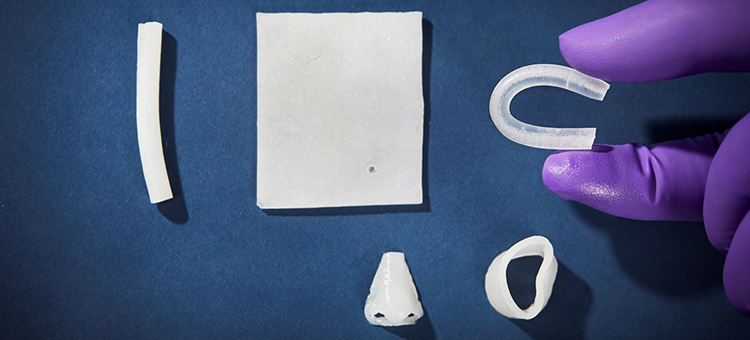Mar 17 2020
At the Chalmers University of Technology in Sweden, scientists have developed a novel, rubber-like material with exclusive properties. The material could serve as a substitute for human tissue in medical procedures.
 Chalmers researchers have developed a new material that could be suitable for various medical applications. The 3D printed “nose” above, for example, shows how the material could act as a possible replacement for cartilage. Image Credit: Chalmers University of Technology.
Chalmers researchers have developed a new material that could be suitable for various medical applications. The 3D printed “nose” above, for example, shows how the material could act as a possible replacement for cartilage. Image Credit: Chalmers University of Technology.
The material is capable of bringing a huge difference in the lives of several people. The study was reported recently in ACS Nano, a renowned scientific journal.
While developing products related to medical technology, there is a huge demand for novel naturalistic materials that are appropriate for incorporation into the body.
The introduction of materials into the human body involves several risks, like serious infections, apart from others. A majority of the substances used at present, like Botox, are highly poisonous. Hence, there is a requirement for more adaptable and novel materials.
In the latest research, scientists at the Chalmers University of Technology have designed a material made entirely from components that have earlier been demonstrated to function well in the body.
The material’s basis is the same as plexiglass—a material commonly used in medical technology applications. By employing a process known as nanostructuring and by reformulating its composition, the team provided the newly patented material a special combination of properties. Initially, the objective of the scientists was to produce a tough bone-like material, but they met with surprising outcomes.
We were really surprised that the material turned to be very soft, flexible and extremely elastic. It would not work as a bone replacement material, we concluded. But the new and unexpected properties made our discovery just as exciting.
Anand Kumar Rajasekharan, PhD, Researcher, Chalmers Institute of Technology
The study outcomes demonstrated that the new rubber-like material might be suitable for several applications that would need an unusual combination of properties such as easy processability, high elasticity, and suitability for use in medical procedures.
The first application we are looking at now is urinary catheters. The material can be constructed in such a way that prevents bacteria from growing on the surface, meaning it is very well suited for medical uses.
Martin Andersson, Study Research Leader and Professor of Chemistry, Chalmers Institute of Technology
Thanks to its structure, the surface of the new nano-rubber material can be treated so that it turns antibacterial, in a non-toxic and natural manner. This is realized by sticking antimicrobial peptides—tiny proteins that are part of the inherent immune system—onto its surface. This can decrease the need for antibiotics, an essential contribution to combat against increasing antibiotic resistance.
Since the novel material can be inserted and injected through keyhole surgery, it also minimizes the need for major operations and surgery to reconstruct parts of the body. It is possible to inject the material through a standard cannula in the form of a viscous fluid, thereby forming its own elastic structures inside the body. Alternatively, it is also possible to 3D print the material into particular structures as needed.
There are many diseases where the cartilage breaks down and friction results between bones, causing great pain for the affected person. This material could potentially act as a replacement in those cases.
Martin Andersson, Study Research Leader and Professor of Chemistry, Chalmers Institute of Technology
An additional benefit of the material is that it includes three-dimensionally ordered nanopores. This implies that the material can be loaded with medicine, for several therapeutic purposes like reducing inflammation and enhancing healing.
This process enables localized treatment, avoiding, for instance, the need to treat the complete body with drugs. This could help bring down problems related to side effects. Thanks to its non-toxic nature, the material also functions well as a filler. Thus, the scientists consider plastic surgery as another intriguing area of application for the novel material.
“I am now working full time with our newly founded company, Amferia, to get the research out to industry. I have been pleased to see a lot of real interest in our material. It’s promising in terms of achieving our goal, which is to provide real societal benefit,” concluded Anand.
The route of the research to societal benefit and commercialization has begun via a start-up company Amferia and Chalmers Ventures
The Path of the Research to Societal Benefit and Commercialization, Through Start-Up Company Amferia and Chalmers Ventures
For commercializing the new material and making its discovery useful, the scientists patented their innovation before publishing the study. The patent belongs to Amferia, a start-up company founded by Martin Andersson and Anand Kumar Rajasekharan, two of the scientists behind the research, as well as researcher Saba Atefyekta who recently completed a PhD in Materials Science at Chalmers.
At present, Anand is the CEO of Amferia and will work toward the application of the novel material and the company’s development.
Earlier, Amferia developed an antibacterial wound patch, for which the company gained recognition. The same team developed the patch. At present, Amferia has the innovation of both the antibacterial wound patch and the new nano-rubber. The company’s development and its path of innovations to reap profits are now being handled in collaboration with Chalmers Ventures, a subsidiary of the Chalmers University of Technology.